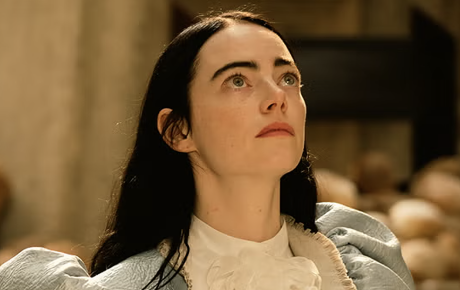I re-watched Poor Things a couple of nights ago (my second viewing), and reacted in a way I hadn’t expected. I felt a bit more dazzled or certainly more appreciative of the multitudinous elements that go into each shot. I was knocked out when I saw it in Telluride in early September, but I expected to have more or less the same reaction. Maybe a slight enthusiasm drop but that’s par for the course and nothing to sweat.
But to my surprise it gained. I was saying “wow” over and over, as much as I did three months ago. Over and over I was shaking my head in admiration for the visual energy…the exacting care and immaculate invention that went into every aspect — the exciting abnormality of it all, the skewed Victorian-era dialogue, Emma Stone‘s robotically out-there manner and behavior, the imaginative artificiality and bizarre production design, the weird performances from pretty much everyone, the perverse humor…all of it. It looks and feels like a weird dream, but one you can easily settle into.
I gradually realized that Poor Things is one of those films that you need to see twice because there’s so much going on that a single viewing won’t suffice.
I was wondering for a while what Poor Things would be like if I saw it on peyote or mescaline. I would never consider such a thing (in my youth I tripped my way through at least three or four films) but it’s a film that would really be enhanced by the right kind of hallucinogen. A gentle one, I mean.

Make no mistake — Poor Things delivers a woke narrative. An attractive and spirited artificial young woman in her 20s encounters the big, bad, male-corrupted world for the very first time with naive, childlike eyes and somehow finds her way through the thicket, and emerges at the end of the tale with an emboldened, seen-it-all feminist attitude. But Bella Baxter’s tale is so inventively told I not only didn’t mind the preach but was taken by it. I didn’t feel the least bit dismayed or disengaged.
I noticed something else that I probably shouldn’t mention but will anyway. I’m talking about the simple biological fact that Emma Stone has large, slender, shovel-like feet. I’m sorry but she’s barefoot in at least half of her scenes, and I was saying “well, there it is…her feet don’t have that petite Japanese geisha thing going on.” No problems or judgments; her anatomy is her anatomy. But I did notice this.
But I was also thinking, “God, what a brave and striking performance…Bella is so eccentric, so stiff-necked (a little like Elsa Lanchester‘s Bride of Frankenstein) and yet so carefully and correctly phrased,m and so willful…such an original concept.
And before Poor Things I was never a huge Yorgos Lanthimos fan, mind. I respected and appreciated his brand and sensibility, but this was the first time I felt really enthused about what he was showing me.
HE: “When I think of Yorgos Lanthimos‘ Poor Things (Searchlight, 12.8), I think of a one-two effect. First I think of Frankenstein’s sexually vigorous daughter, and then a back-from-the-grave woman whose worldview evolves from wide-eyed wonderment into critical male-shirking wokeness. I also believe that Emma Stone has the Best Actress Oscar in the bag.”
Friendo: “When I think of Poor Things, I first think of a lurching, amusing and sometimes audacious [effort] that feels second-rate-ish at the end of the day. Then I think of the in-your-face woke design (Ms. Barbie Frankenstein in a world of angry, damaged, predatory men!), then I think of all that sex and how it’s really kind of gratuitous (unless this were 1972) but wow, it sure is going to help sell the movie!”
